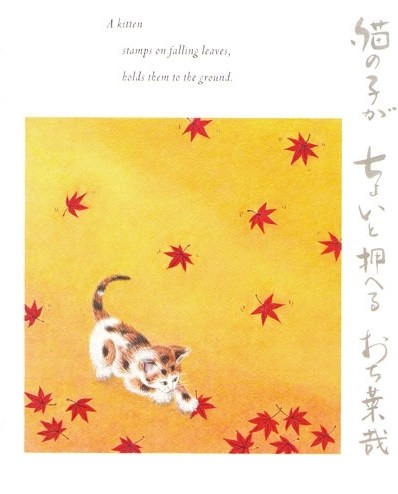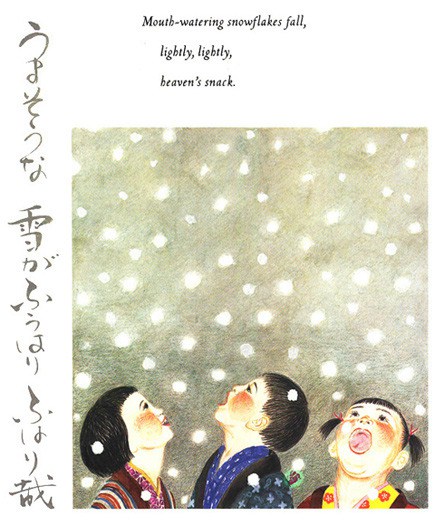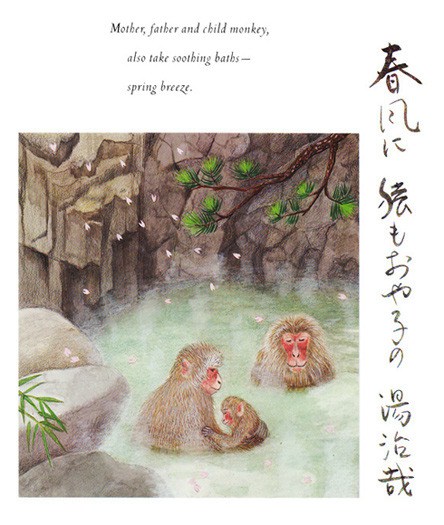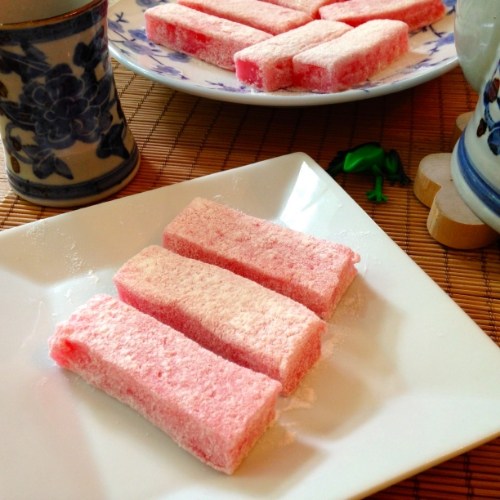
Ohayoo gozaimasu! Good Morning!
Please help yourself to a nice warm cup of Genmaicha (green tea with brown rice) and a piece of chi chi dango mochi. I remember many a time when my mother made a pot of Genmaicha after a good meal — a soothing way to cleanse the palate and set the stage for some lively ‘talk story.’
A couple of weeks ago, I searched Lee and Low’s website for books I hadn’t yet read and found the perfect picture book to share for Asian-Pacific American Heritage Month. Cool Melons — Turn to Frogs!: The Life and Poems of Issa by Matthew Gollub and Kazuko G. Stone was first published in 1998, so many of you are probably already familiar with it. How did I miss it? I’m so glad I finally read it, as now it’s one of my favorite haiku picture books ever.

I love how every aspect of this book embodies the essence of haiku — its complex simplicity, beauty, elegance, and ability to open the eyes, refresh the mind, and inspire contemplation.
Gollub seamlessly interweaves the details of Issa’s tragic life of loss, abandonment, and poverty with 33 haiku carefully chosen by Stone to illuminate various stages of his life. Stone’s beautiful watercolor and colored pencil illustrations, visual poems in themselves, mirror and deepen each haiku moment with eloquence, restraint, and charming details. Each haiku is also presented in Japanese calligraphy down the side margins, evoking Issa’s free-flowing brush strokes and the spontaneity of his observations.

I read with great interest how Issa began to write haiku at a very young age. After losing his mother at age 3 and then being mistreated by his new stepmother, writing became his comfort and solace. Already one who loved to spend hours alone observing the wonders of the natural world, Issa discovered that haiku enabled him to express his inner feelings. His father encouraged his studies and was proud of his poems, but Issa’s stepmother considered them a waste of time. Because Issa and his stepmother constantly quarreled, Issa’s father reluctantly sent him away when he just fourteen, forcing him to fend for himself far from the mountain village where he was born.


Issa traveled to Edo (Tokyo), where he survived by taking odd jobs. Sometimes he went hungry, but somehow he kept writing, noticing “little things that most people were too busy to see.” Eventually he apprenticed himself to a poet master, published his poems, and was asked to run the academy. But Issa decided he’d rather write and see more of the world than teach formal classes.



For seven years he traveled extensively around Japan by foot in the tradition of haiku poets. He frequented Buddhist temples where he was given food and shelter. He eventually returned to his father’s village, but after his father died, he quarreled with his stepfamily over his property inheritance. He married at age 51 but then lost his two-year-old daughter to smallpox. More sorrow and hardship followed with the death of several more children and his beloved wife, an unsuccessful second marriage, and the loss of his house in a fire.
Still, he found solace in writing haiku. And, despite the sadness that shadowed his life, he brought cheer to his many friends and inspiration to students.

Issa’s affection for birds and insects — the small creatures he encountered and wrote about with childlike simplicity — endeared him to the Japanese people. He was the most prolific of the haiku masters, having written about 20,000 verses in his lifetime, and his candid conversational tone (confessional at times) and sense of humor made his work very accessible. It is remarkable and inspiring how such positivity came from a man who experienced so much sorrow and adversity; perhaps this once again illustrates the power of poetry to heal, comfort and transform.


Issa’s haiku resonates with readers today just as strongly as it did centuries ago. With his critical eye and innate empathy with the natural world, he was able to create startling verses of lyrical beauty while revealing the essential loneliness of a solitary soul.
Once, when he saw watermelons left outside to chill, he felt sorry that someone would soon eat them up. If only, he wished, they could hop away, then people would leave them alone!

Cool melons —
turn to frogs!
If people should come near.
Gollub has written a wonderful Author’s Note which includes background information on several of the haiku, his translations, and about haiku in general. It is easy to see why this classic introduction to master Issa earned so many awards and accolades, including the Asian Pacific American Award for Literature (Children’s and Young Adult Category). As Issa also liked to combine prose with poetry, this picture book is truly a fitting representation of him and his work.
* * *

WHAT IS CHI CHI DANGO?
Saying “chi chi dango” is almost as fun as eating it. 🙂
These soft and chewy confections/Japanese “dumplings,” are made with sweet rice flour and coconut milk and are very popular in Hawai’i. Though I love all forms of mochi now, chi chi dango was a special childhood favorite because it didn’t have the sweet azuki bean filling of regular round mochi rice cakes. It was deliciously plain and like biting into a slightly sweet, mildly nutty cloud. Such a yummy treat — something my mom never made, only purchased every now and then.
As a college student I remember there was a small mom and pop grocery store within walking distance of campus that sold a variety of local goodies like kakimochi (Japanese rice crackers), Chinese dried preserved fruits, collectively known as “seed” (shredded mango, li hing mui, sweet sour plums), Tomoe Ame (sweet rice jelly candy), Iso peanuts, sesame seed candy and senbei (sweeter baked fortune cookie type crackers). They also carried chi chi dango, always fresh and delicious, a direct line to childhood and simpler times. It is traditionally eaten for Boy’s or Girl’s Day, but is the perfect dessert or snack anytime, anywhere. So good!

Although today chi chi dango is widely available in local Hawai’i supermarkets, it is easy to make at home, even a home as far away as Virginia. You can find Mochiko, usually sold in one pound white boxes, in Asian grocery stores or sometimes in the international foods section of supermarket chains. It’s just a matter of combining wet and dry ingredients, baking the mixture for a full hour at 350 degrees, and then letting it cool completely (preferably overnight) before slicing and dusting with potato starch. Goes perfectly with green tea and tends to disappear in a flash.
Speaking of tea, did you know that “Issa” means “cup-of-tea”? Former Poet Laureate Robert Haas translates it as “a single bubble in steeping tea.” Issa was born as Kobayashi Yataro, later adopting “Issa” as his pen name. I can’t think of a better name, can you? Another reason to love him :). I imagine he would be quite pleased if you sipped some green tea and enjoyed a few pieces of chi chi dango in his honor. Oishi!

CHI CHI DANGO RECIPE
*wheat free and dairy free
Ingredients
- 1 pound mochiko (glutinous rice flour)
- 2 cups granulated sugar
- 1 teaspoon baking powder
- 2 cups water
- 1 teaspoon vanilla extract
- 1 (14 or 15 oz) can coconut milk (I used Whole Foods 365 brand)
- 1/4 teaspoon food coloring (optional)
- 1-1/2 cups potato starch
Directions
1. Preheat oven to 350 degrees. Grease a 9″x13″ glass baking dish. Whisk together the rice flour, sugar and baking powder; set aside.
2. In a medium bowl, mix together the water, vanilla, coconut milk and food coloring (if using). Blend in the rice flour mixture. Pour into the prepared pan.
3. Cover the pan with foil (make a little “tent” in the middle) and bake for one hour. Allow to cool completely (minimum 4-5 hours, preferably overnight).
4. Turn the pan of mochi out onto a sheet of parchment paper lightly dusted with potato starch. Cut into bite size pieces using a plastic knife (wrap the blade in plastic wrap for easier slicing). Roll pieces in potato starch and shake off excess before serving. Stays fresh for 1-2 days in an airtight container.
Notes: The mochi will not stick if you cut it with a plastic knife. If you don’t have potato starch on hand, you may dust the pieces with a little mochiko flour. The foil tent will help the middle cook as evenly as the edges. Don’t worry about the “crust” that forms around the edges of the pan. Given time to cool, this edge will soften. Do not try to use regular rice flour for this recipe. You must use Mochiko, no substitute.
* * *

COOL MELONS — TURN TO FROGS!: The Life and Poems of Issa
story and haiku translations by Matthew Gollub
illustrations by Kazuko G. Stone
published by Lee & Low Books, 1998, 2013
Picture Book for all ages, 32 pp.
* * *
 Haiku lover and poet Diane Mayr is hosting today’s Roundup at Random Noodling. Hop over and check out the full menu of poetic goodness being served up in the blogosphere this week.
Haiku lover and poet Diane Mayr is hosting today’s Roundup at Random Noodling. Hop over and check out the full menu of poetic goodness being served up in the blogosphere this week.
Domo Arigato (Thank you very much)!
*bows*
———————————-
Copyright © 2015 Jama Rattigan of Jama’s Alphabet Soup. All rights reserved.

What an amazing life story. The poems and art are sublime. Thanks, Jama.
LikeLike
It’s a beautiful book! I was surprised to learn about Issa’s hard life.
LikeLiked by 1 person
Tempting Japanese dumplings. BTW I am very fond of Japanese food.
LikeLiked by 1 person
I love Japanese food too. Hope you try this recipe sometime. It’s easy as long as you find some Mochiko and coconut milk. 🙂
LikeLiked by 1 person
I don’t think so that these 2 ingredients are hard to find. I’m craving for the recipe. Great poetry. Have a yummilicious weekend 🙂
LikeLike
Nice story!
LikeLiked by 1 person
what a perfectly lovely book! thank you for introducing me to it, Jama!
LikeLike
It’s really lovely — and a good intro for adults as well as kids.
LikeLike
Thanks for explaining chi chi dango! I hope to try it some day! Here’s one of my favorite Issa poems:
the kitten dances
round and round…
falling leaves
LikeLike
Love that one, Diane. There’s such a sense of playfulness and optimism in this haiku. I can just picture those wonderful images.
LikeLike
I love that Issa means ““a single bubble in steeping tea.” ❤ Very poetic. That illustration of the monkeys bathing is so charming, and I love the book cover.
LikeLike
He’s got the perfect pen name!
LikeLike
Jama, I hung on to every word of your post and was fascinated by Issa’s haikus especially the tone with the dragonfly. You served up another tasty treat for today’s Poetry Friday.
LikeLike
Glad you enjoyed reading about Issa, Carol. If you haven’t yet seen this book, it’s definitely worth tracking down!
LikeLiked by 1 person
Jama, I’m so glad you featured this book, which I own and love. I also like a collection of translations for grownups by David G. Lanoue, Issa: Cup of Tea Poems, in which he writes the poems one word at a time vertically like the brush stroke versions. One favorite is this poignant haiku: “made/with/sooty/paper/the/stepchild’s/kite.” Thank you!
LikeLike
Oh, thanks for mentioning Lanoue’s book, Kate. I’ll definitely look for it!
LikeLike
Jama, I recently heard of this book and now I am even more eager to own a copy! Issa was a truly talented poet, and continues to inspire so many. The book Kate mentioned sounds great, too!
LikeLike
Yes, you must get a copy! I don’t think the hardcover is being published anymore, but it’s definitely available in paperback. 🙂
LikeLike
Jama, I love this book. I really need to get the book. SEnd the Mochi recipe to my niece.
LikeLike
Yes, you need this one, Jone! Hope your niece enjoys the recipe.
LikeLike
I must get this book, Jama! Each haiku was such a delight to enjoy and linger over. As was your recipe for chi chi dango; I love mochi, so this might be something to try making at home. Especially the way you described them, Jama: a slightly sweet, mildly nutty cloud.
LikeLike
I hope you try this recipe, Tara. It’s easy once you get the right ingredients. And the book is quite a gem.
LikeLike
I do love this book — everything from the title to the art to all the lovely poems.
LikeLike
There’s such a beautiful serenity about the art — a perfect pairing of author and illustrator.
LikeLike
What a wonderful book. I love the haibun form, with prose and poetry. I was thinking of writing a picture book that would combine the two.
LikeLike
What a good idea, Brenda! I enjoy haibun too. 🙂
LikeLike
Of course I’m in love with this post. One of my favorite picture books, and you’ve thoughtfully done it justice. Thanks for the amazing recipe and backstory, too! This weekend I get to see our current Haiku Society of America president David G. Lanoue at our conference – he is an Issa scholar and has translated Issa’s poems – you can sign up for an Issa poem to appear in your inbox each day! (Haikuguy.com)
LikeLiked by 1 person
Lucky you! Kate Coombs just mentioned David’s book. I’m even more curious to see it now.
LikeLike
This book looks like a beautifully crafted blend of illustration and verse. I love other forms of poetry, but I’ve especially acquired a fondness for the simplicity of the haiku. Oh, and chi chi dango has always been a favorite, too. 🙂
LikeLike
Didn’t know you liked haiku, Julia. Do you write them too?
LikeLike
Jama, I love this book! Another book that I’ve enjoyed sharing with students is Haiku: Asian Arts and Crafts for Creative Kids. We actually made small folded books one year with The Seven Keys to Writing Haiku from this book.
LikeLike
Thanks for mentioning that book, Ramona — I’ll have to keep an eye out for it.
LikeLike
Lovely post! Both the book and the chi chi dango look wonderful.
LikeLike
Thanks for visiting!
LikeLike
Thank you for this post. I enjoyed the haiku, the art and the story of Issa’s life. And as for the mochi – I want to try some!
LikeLike
Hi Sally! Hope you try the recipe sometime :).
LikeLike
As always, Jama, so many good reasons to stop by. When will someone offer to publish selections from your blog as a poetry cookbook?!
LikeLike
Thanks, Heidi! You are too kind :).
LikeLike
i love mochi but never had this brand before, tempting to try!!!
LikeLike
I hope you try it!
LikeLike
I can’t believe that I have not heard of this book either! Must remedy PDQ. I am not adventurous in the kitchen, but this “chi chi dango mochi” is lindy hopping all over my tongue, just begging to be made.
LikeLike
You should make it — do you like mochi to begin with? If so, this is a very easy way to get a mochi fix.
LikeLike
Really cool! 😀
LikeLike